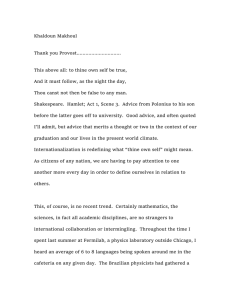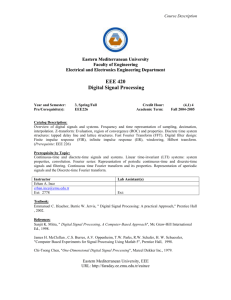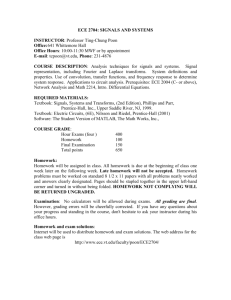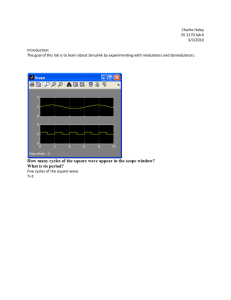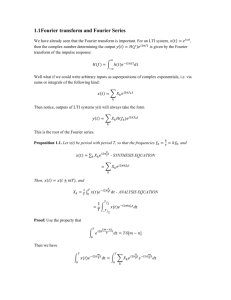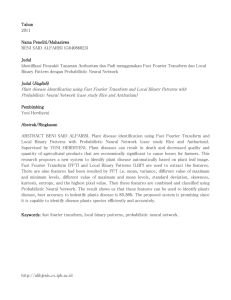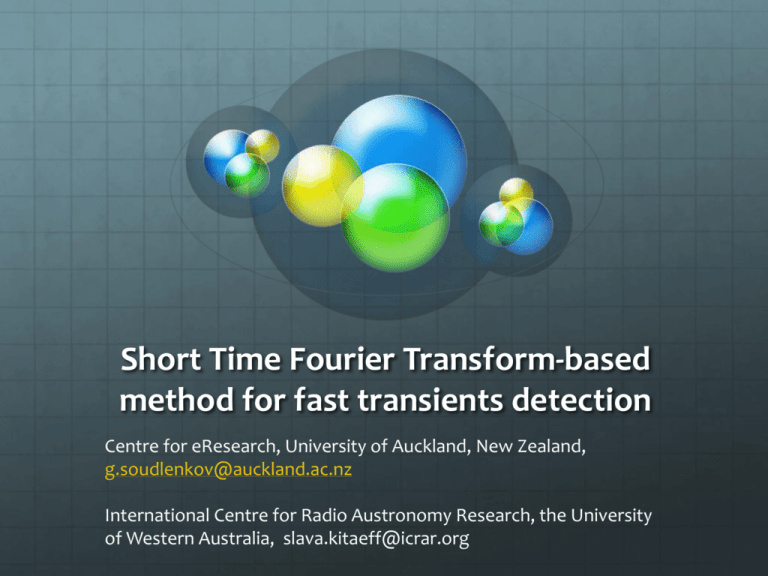
Short Time Fourier Transform-based
method for fast transients detection
Centre for eResearch, University of Auckland, New Zealand,
g.soudlenkov@auckland.ac.nz
International Centre for Radio Austronomy Research, the University
of Western Australia, slava.kitaeff@icrar.org
Fast transients search
• Lack of regularity/periodicity
Frequency evolution and
integrated pulse shape of the
radio burst. The survey data,
collected on 24 August 2001, are
shown here as a two-dimensional
“waterfall plot” of intensity as a
function of radio frequency versus
time. The dispersion is clearly
seen as a quadratic sweep across
the frequency band, with
broadening toward lower
frequencies. (Lorimer, 2007)
Fast transients search
• Lack of regularity/periodicity
• Multiplicity of sources – Cerenkov emission, gamma-ray
bursts, RRATs, synchrotron radiation
Fast transients search
• Lack of regularity/periodicity
• Multiplicity of sources – Cerenkov emission, gamma-ray
bursts, RRATs, synchrotron radiation
• The solution is to be scalable
Fast transients search
• Lack of regularity/periodicity
• Multiplicity of sources – Cerenkov emission, gamma-ray
bursts, RRATs, synchrotron radiation
• The solution is to be scalable
• The solution must be computationally inexpensive
Short Time Fourier
Transform
• Transforms from time to join time/frequency domain
“An arbitrary function, continuous or with
discontinuities, defined in a finite interval by an
arbitrarily capricious graph can always be
expressed as a sum of sinusoids”
J.B.J. Fourier
Jean B. Joseph
Fourier
(1768-1830)
Short Time Fourier
Transform
• Transforms from time to join time/frequency domain
Nobel Prize in Physics, 1971, inventor of
holography – and the one who introduced
time/frequency transforms (paper on Gabor
transform published in 1946)
Dennis Gabor
(1900-1979)
Short Time Fourier
Transform
• Transforms from time to join time/frequency domain
¥
STFT{x(t)} º X(t , w) = ò x(t)w(t - t )e
-¥
- jwt
dt
Short Time Fourier
Transform
• Transforms from time to join time/frequency domain
spectrogram{x(t)} º| X(t , w) |
2
Short Time Fourier
Transform
• Transforms from time to join time/frequency domain
• Signal assumed stationary within short window
Short Time Fourier Transform
Spectrograms
© 2009 National Instruments Corporation. All rights reserved.
Short Time Fourier
Transform
• Transforms from time to join time/frequency domain
• Signal assumed stationary within short window
• Maps signal into two-dimensional function in
time/frequency plane
Short Time Fourier
Transform
• Transforms from time to join time/frequency domain
• Signal assumed stationary within short window
• Maps signal into two-dimensional function in
time/frequency plane
• Algorithm has relatively low computational
complexity and provides good ground for
parallelized solution
Short Time Fourier
Transform
• Transforms from time to join time/frequency domain
• Signal assumed stationary within short window
• Maps signal into two-dimensional function in
time/frequency plane
• Algorithm has relatively low computational
complexity and provides good ground for
parallelized solution
• Disadvantage: difficulty in obtaining satisfactory
resolution in both domains (Fourier uncertainty
principle)
STFT is a drawing board
- over noise background
•
Noise is considered to be normal
•
•
•
Zero mean
Constant variance
Zero correlation
•
Spectrum is approximately exponential
•
Cox-Box transform can make spectrum sequences to be
approximately Gaussian AR(1) process
•
Local signal can now be detected as a series of outliers in
frequency bands
Cells scoring – stage 1
• Mean frequency band - MFB
• Mean power in MFB
• Cells – windows with regular time width
Cells scoring – stage 1
• Mean frequency band - MFB
• Mean power in MFB
• Cells – windows with regular time width
• Use of centralized cells reduces negative impact of
edge effect
Cells scoring – stage 1
• Mean frequency band - MFB
• Mean power in MFB
• Cells – windows with regular time width
• Use of centralized cells reduces negative impact of
edge effect
• Each cell is assigned a score
Cells scoring – stage 1
T (X,Y ) =
m X - mY
2
2
s X / N X + s Y / NY
P(X,Y ) = erf (T(X,Y )´ 2)
Zi Î {K}"i, P(Zi , S) ³ t
Cells scoring – stage 2
• Cells are sorted in score descending order
• Identify signal-bearing cells
• Make sure this signals are of interest
Cells scoring – stage 2
• Identify signal-bearing cells
• Make sure this signals are of interest
• Implementation solution uses outliers trains
counting in frequency bins
Cells scoring – stage 2
• Identify signal-bearing cells
• Make sure this signals are of interest
• Proposed implementation uses outliers trains
counting in frequency bins
• Other methods can use statistical properties of STFTtransformed noise
Cells scoring – stage 2
• Candidate cells marked for further investigation have
identified dispersion measure
• Incoherent de-dispersion is easy and computationally
inexpensive
• Coherent de-dispersion can be done if full content of
the original Fourier transform remains (real and
imaginary parts)
Vela (PSR J0835-4510)
Vela (PSR J0835-4510)
•
Observed in 1968
•
Period of 89 ms
•
Dispersion measure 68 pc*cm^-3
Vela (PSR J08354510)Detector results
…
Pos: 79, sec: 0.632000 *
Pos: 80, sec: 0.640000
Pos: 90, sec: 0.720000 *
Pos: 101, sec: 0.808000 *
Pos: 112, sec: 0.896000 *
Pos: 123, sec: 0.984000 *
Pos: 134, sec: 1.072000 *
Pos: 144, sec: 1.152000 *
Pos: 145, sec: 1.160000
Pos: 156, sec: 1.248000 *
Pos: 166, sec: 1.328000 *
Pos: 167, sec: 1.336000
…
Stable period of 88 ms is visible now
Vela (PSR J0835-4510)
Time/frequency representation of pulsar J0835 − 4510, observed at Parks telescope, central
frequency 1416 MHz, bandwidth 64 MHz, recorded with 2-bit VLBI recorder. Recording
started at 2009.12.10 − 17 : 25 : 51UTC.
Single pulse
Vela (PSR J0835-4510)
Portion of the spectrum stripe with detected and de-dispersed pulses
Single pulse – de-dispersed
Acknowledgments
We would like to thank Dr. Aidan Hotan of
Curtin Institute of Radioastronomy, Dr. Joeri
van Leeuwen
from Astron, Dr. Duncan
Lorimer from West Virginia University for the
data been made available .
Questions

